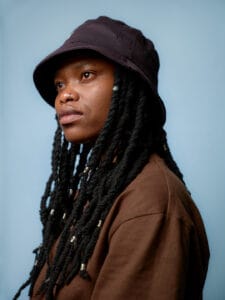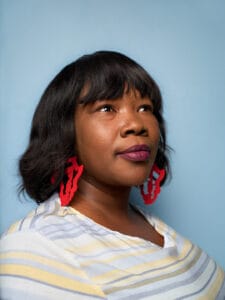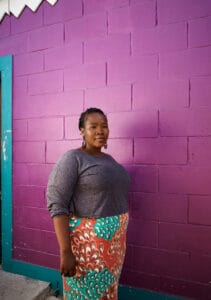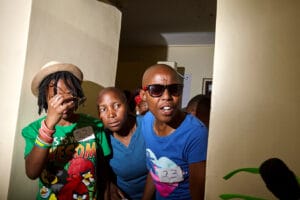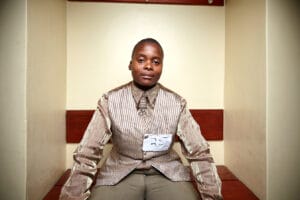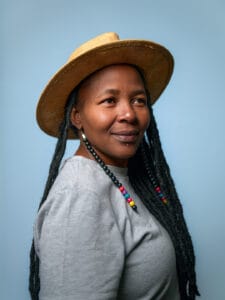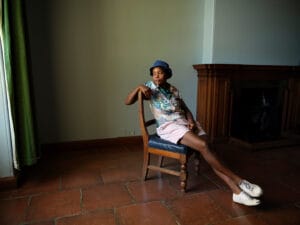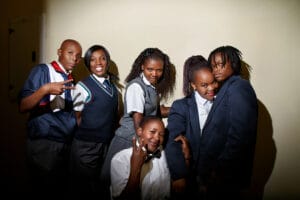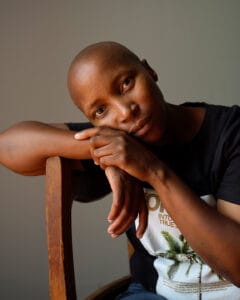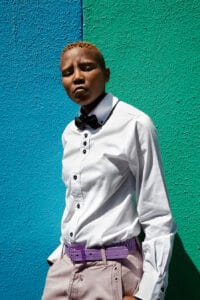Observations & Recommendations
LGBTQ characters continue to shine in leading roles spanning genres.
Of the 170 LGBTQ characters counted in 2023 films, 38 percent of them had over ten minutes of screen time. Further, 56 percent of all LGBTQ-inclusive films featured LGBTQ characters with over ten minutes of screentime. Seeing queer people at the forefront of mainstream stories is exactly what this study advocates for, and it is exciting to see across 2023’s slate of films. Biopics including Netflix’s Rustin and Amazon Prime’s Cassandro told the stories of real life gay men of color who are often overlooked. MGM’s Bottoms and Searchlight’s Theater Camp put queer people at the center of laugh out loud comedies, while Warner Bros.’ The Color Purple and Searchlight’s All of Us Strangers had queer leads in tear-jerking dramas. There were also queer leading characters in horror films, such as Universal’s Knock At the Cabin, Lionsgate’s The Blackening, and Paramount’s Scream VI, as well as major LGBTQ characters in kids and family movies, from Netflix’s animated Nimona to the Paramount+ sequel Monster High 2. While the total number of LGBTQ characters has decreased year over year, quality is just as important as quantity, and it is gratifying to see that centering LGBTQ characters has remained a priority. GLAAD urges Hollywood to continue and build upon this commitment in the years ahead.
Transgender representation is alarmingly low—and at times, blatantly offensive.
Of 70 LGBTQ-inclusive movies and 256 total films counted, only two contained transgender characters. Searchlight’s Next Goal Wins includes trans soccer player Jaiyah, based on a real person who is a national hero in American Samoa. The film cast a Samoan fa’afafine actor to play Jaiyah, and her performance is the highlight of the film. However, the story is centered on a white coach who misgenders Jaiyah and asks her offensive questions about her body and her medical transition. The actress and Jaiyah herself deserved better. In Sony’s ¡Que viva México!, the lead’s trans sister, Jacinta, is subjected to mockery and transphobic dialogue, and even worse, she is played by a male cisgender actor, reinforcing the false and deadly narrative that trans women are simply men in dresses. Given that over 600 anti-trans laws have been introduced in 2024 alone, the danger of these one-dimensional and/or offensive, transphobic narratives reaching the big screen cannot be overstated. Hollywood must do better by telling stories about transgender people that portray them as complex people with full and complicated lives, just like everyone else. The most powerful step forward Hollywood could take is empowering transgender people to tell their own stories.
Racial diversity of LGBTQ characters in film has increased across the board, but Black LGBTQ representation remained stagnant and there were zero LGBTQ indigenous characters.
In 2023, 46 percent of the LGBTQ characters counted in this study are characters of color. This is a welcome uptick from last year’s 40 percent, with LGBTQ characters of color taking center stage in films like Rustin, The Blackening, The Color Purple, Shortcomings, Joy Ride, The Persian Version, Cassandro, and more. However, there is still work to be done. Though Black LGBTQ representation remained at 17 percent year over year, Black LGBTQ characters with over 10 minutes of screentime dropped from 19 percent down to only 11 percent. Black LGBTQ people have been a historically under-represented demographic, so it is disheartening to see that number decreasing year over year. Further, there were zero indigenous LGBTQ people in GLAAD’s count, a drop from last year’s already meager count of two. This is an area of representation where Hollywood has historically failed. GLAAD commends Apple TV+’s 2024 release Fancy Dance, which features a queer indigenous lead, but one film is not enough to represent the wide spectrum of indigenous identity, and we implore studios to prioritize telling more LGBTQ indigenous stories.
LGBTQ characters with disabilities are nearly absent.
After 11 LGBTQ characters were counted with a disability in 2022, it is disappointing to see that number drop down to only two characters, representing only one percent of LGBTQ characters. These characters were in Netflix’s Nimona, where co-lead Ballister Blackheart is an amputee, and Amazon’s American Fiction, where the lead’s brother Cliff is a person with a substance use disorder. In a 2019 study by the Movement Advancement Project, two of five transgender adults and one in four lesbian, gay, or bisexual+ adults reported having a disability. 2023’s film slate, in which only two of 170 LGBTQ characters have a disability, is a stark contrast to reality, and leaves a significant portion of the LGBTQ community unrepresented. Further, in 2023 films there were no characters represented who were living with HIV. After last year’s standout Three Months, it is extremely disappointing that not one of the 256 films or 70 LGBTQ-inclusive films featured LGBTQ characters living with HIV. According to GLAAD’s State of HIV Stigma survey, Gen Z is also the least knowledgeable generation about HIV. Members of Gen X are nearly twice as knowledgeable about HIV than Gen Z. While over 60 percent of Gen X say they are knowledgeable about HIV, only 34 percent of Gen Z adults say the same. Film is a powerful tool to communicate stories of HIV to younger generations, and it is disappointing that people living with HIV are completely absent from 2023 films, especially when there were at least two opportunities to introduce new HIV storylines on film that year in films based on real life stories.
LGBTQ characters are being left behind or minimized in adaptations of source material.
As has long been the case, many films based on source material of books, comics books, TV shows, and other media have lost the LGBTQ content of the original. While many comic book movies were heading in the right direction and including explicitly LGBTQ characters, there has been a disappointing backslide. Every inclusion in the Marvel Cinematic Universe was from characters that were confirmed as queer in other media (Valkyrie in Thor: Love and Thunder and Loki in Loki), and were both in their respective films for less than one minute each. Further, films based on books or audiobooks, such as The Hunger Games: The Ballad of Songbirds and Snakes from Lionsgate and When You Finish Saving the World from A24, erased the queerness that was present in the source material. Two Paramount+ films, A Really Haunted Loud House and Teen Wolf: The Movie, were adapted from TV shows on Nickelodeon and MTV, respectively. The Loud House movie did not include the queerness of any LGBTQ characters on the show, and the Teen Wolf movie only included one brief reference to a gay character’s partner, even though there were multiple queer characters from the show in the film. These adaptations already have the groundwork laid for easy LGBTQ inclusion, so it is disappointing that time and time again these LGBTQ characters fail to make it to the big screen. GLAAD urges Hollywood to stay faithful to and expand upon a source material’s LGBTQ representation when adapting queer-inclusive media, rather than eliminating it altogether.
LGBTQ people are still being reduced to the “gay best friend” trope.
While there has been a push for LGBTQ people to lead romantic comedies, it still seems that the queer community exists in this genre solely to support straight love stories. This year saw the release of Amazon’s queer romantic comedy Red, White & Royal Blue, which led to huge success for the streamer and garnered masses of new subscribers. Yet, in the same year there were a large number of less successful films in the genre that relegated queer characters to the sidelines.. While some films had LGBTQ supporting characters in the fabric of the universe that had their own love stories, like Sony’s Anyone But You and Hulu’s Rye Lane, many other films used queer people simply as wallpaper. Movies like Sony’s Love Again, Netflix’s Your Place or Mine and Happiness for Beginners, and Paramount+’s At Midnight, fell back on the old trope of including a queer person (usually a gay man) as the sole confidant for the straight romantic hero without giving them their own plot. Romantic comedies have historically been embraced by the LGBTQ community, and they deserve to see queer love stories in film. Studios have a responsibility to authentically represent their consumers, and that includes centering queer love stories rather than relegating them to the sidelines.
LGBTQ stories are lacking in the kids and family space.
In 2023, there were only four kids and family films that included LGBTQ characters. That is a 50 percent decrease from last year’s study. While films like Netflix’s Nimona and Paramount’s Monster High 2 featured compelling LGBTQ characters aimed at younger audiences, and films like Universal’s Ruby Gillman: Teenage Kraken and Walt Disney’s Elemental featured them in smaller, casual roles, the overall lack of representation in the kids and family genre is disappointing. Last year, GLAAD called for more representation in this area, and rather than stepping up, studios told even fewer LGBTQ stories in kids and family films this year. As LGBTQ youth continue to be a target of political extremists, it is paramount that the young people have media to consume that authentically portrays their identities, and shows LGBTQ families woven into the fabric of these stories.

